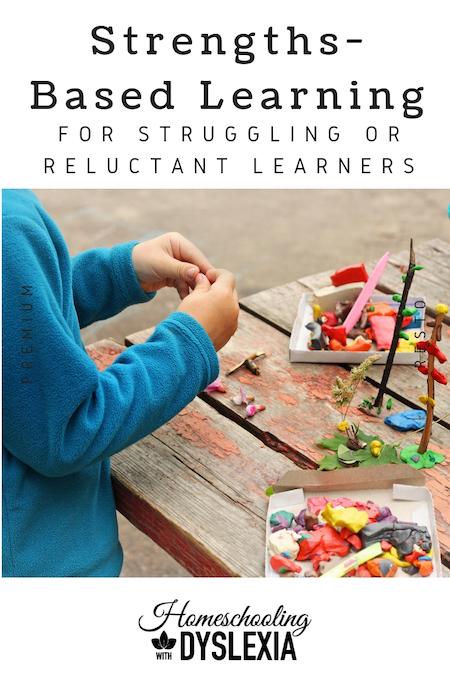Would you like to learn a teaching method that fosters resilience and confidence in your kids? What if this method caused kids to be excited for learning, earn higher GPAs, and have more hope for their futures? I thought so! Let me tell you a bit about strengths-based teaching and learning. This is especially important in the teaching of kids who are reluctant or struggling to learn by traditional methods.

The current mindset in education is to find a student’s area of weakness and fix/remediate it. This is similar to the medical model of disease; find pathology (what is wrong with a patient) and fix it. We see a child who is struggling to learn, we assess them, and form a plan to work on and get rid of the weakness.While on the surface this sounds like a good plan, there has been a movement towards looking at learning struggles as learning differences as opposed to disabilities. These learning differences require teaching differences. Strengths-based teaching is one way to do this.
Research (Clifton & Harter, 2003: Clifton & Nelson, 1992) has shown that capitalizing on one’s best qualities leads to greater success than by making a comparable effort into overcoming weaknesses or deficiencies. In other words, more progress is made by working on strengths than on trying to fix weaknesses.
So while a struggling reader would traditionally spend significant amounts of time on remediation of that weakness, in a strengths-based approach, this child would spend a shorter amount of time working on reading and then spend more time working in areas that strengths.
Elements of Strengths-Based Learning
The foundation of strengths-based learning is understanding and believing that all students have potential and with the right kinds of teaching, these can be drawn out. Successful strengths-based learning includes helping the student to believe in their own potential as well.
Modeling: Strengths-based education begins with the teacher (or parent) modeling how they themselves recognize and develop their own strengths. This comes fairly naturally to us as parents and is a good reminder that our relationships (and communication) with our kids is one of, if not the most important things we can provide for our kids.

Measurement of Strengths: Achievement tests are often how we measure which kids are the good students. For strengths-based learning, you’ll want to do an informal assessment of your child’s strengths and interests – both academic and non-academic.
Shawna Wingert has a free, downloadable worksheet to guide you through this process on her web site, Different by Design Learning here. Be sure to follow her site as she posts on how she is using strengths-based learning in her homeschool as well.
Individualization: This is where the magic happens. Once you have the strengths/interest profile of your child, it’s time to create a personalized learning experience. This is often done spontaneously as you think about and work with your child’s unique strengths, interests, and needs. This individualization helps direct attention, motivate, lead to persistence, and spark action that leads to development of interests, discoveries, use of knowledge, strategies, and skills. In other words, driven by interest and an enjoyment of learning, our kids are pulling on all of these areas of thinking in a unique learning experience.
Collaborative learning: Research shows that strengths develop best in response to other human beings (Clifton & Nelson, 1992). In collaborative learning, individual strengths can be leveraged to compensate for others’ weaknesses. Successful college students repeatedly told researchers that it was support from others that had the biggest impact on their success.
A great example of this kind of collaborative learning is the robotics camp my sons attended this summer. Kids were put in pairs and set about to program and build their robots to compete in a ‘battle’ at the end of camp. In one son’s case, he designed the structure of the robot to have the best leverage during battle, while his partner programmed the ‘brain’ of the robot. Programming at this point is confusing to him but engineering is (and always has been) a strength.

Deliberate use of strengths. Teachers model how they use their own strengths in the day-to-day and create opportunities for students to choose assignment types that allow them to use their strengths. Teaching from a strengths-based perspective requires teachers to devote effort to helping students notice and identify when their strengths are making a difference in learning or when they are using personal strengths to complete assignments with a high level of quality.
An example of this is my son with profound dysgraphia. He can dictate a phenomenal story complete with grammatically correct sentences and the kinds of ‘above grade level’ vocabulary any English teacher would swoon over. If he had to write or type this story, the outcome would be vastly inferior. When I allow him to dictate his stories to me, I am allowing him to shine. He is unhindered by his weaknesses and can dive deep into his narrative storytelling strengths.
When I draw his attention to the difference between the words he can speak and the words he can write, I am helping him to understand his own strengths and weaknesses. He can begin to see himself as gifted and talented despite the fact that his physical writing is weak, which builds his confidence, which in turn builds motivation.
Intentional development of strengths. An ideal strengths-based educational model includes involvement in extracurricular activities, internships, mentoring relationships, or other targeted growth opportunities. Students must be reminded that their continued learning and development will require intentionality and effort. Merely identifying and affirming strengths can inadvertently encourage students to adopt what is known as a fixed mindset.
Students with fixed mindset believe that their strengths are fixed and no amount of effort will change that. They frequently believe that if success requires hard work, they lack innate ability in that area and therefore are more likely to give up on tasks that require prolonged effort. In contrast, students with a growth mindset have the belief that personal abilities can change and so such students often see hard work as necessary for developing their abilities and therefore is something to be embraced.
Read more about how to teach your child to have a growth mindset here.
But will this work for me?
For me as a long time homeschooler with years and years of ‘in the trenches’ experience teaching my outside the box learners, my gut tells me that a strengths-based approach is the best thing for my kids. Years of walking beside my kids and watching them experience different types of learning has shown me that strengths-based learning works.
Even research proves that this is true. Yet, stepping beyond the box of traditional learning is somehow frightening. We’re so used to the traditional, focus-on-the-weakness approach to teaching that we worry that we will mess up our kids or limit their future potential.
Could this type of learning possibly be enough? Research shows that when students experience satisfaction and competence in their learning, they improve in all subjects. Why? There are no clear cut answers. It could be increased motivation or confidence.
What about higher math, foreign language, etc? Kids who learn differently also learn on a different time frame. Allowing our kids to progress at their natural pace seems frightening but it does work.
Resources
Shawna Wingert: Former corporate trainer turned strengths-based homeschooler, Shawna Wingert, writes that “research also surprisingly showed that a learner, when allowed to progress in a ‘strengths based’ approach, increased his overall capabilities and performance, even in the areas that were weaknesses.” Read more from Shawna here.
How We’re Using Strengths-Based Learning in Our Homeschool
While strengths-based learning can make a huge impact on the educational experience for our struggling or reluctant learners, it does take a lot of courage and conviction to follow through with because it looks so different from what we all grew up with in traditional school.
I’ll be sharing more on the blog about books and websites that I am reading that are helping me to grow in my courage and conviction. For now, we are continuing with our educational therapy even though my young sons really dislike it. It’s not that there is anything inherently wrong with educational therapy-it really does work! I’m not ready to give that up yet. We’ve invested quite a few years in the process and have seen some good results.
How we are using strengths-based learning is to pull way back from traditional academics in other subjects in order to focus on interests. I am actually keeping a list on my phone of all the questions that my boys ask during the day. There are lots of them! I just never really paid much attention to them in the past.
During the day we will research their questions online and where I see more interest we dive deeper or take off on those proverbial rabbit trails that homeschoolers complain derail all of their best laid plans.
I am continuing to observe their interests and am allowing them to learn in ways that are enjoyable for them (video and audio books). We’re having discussions throughout the day and even into the evening many days as ideas change and develop in their minds.
My observations so far? It has been an amazing, organic, and natural way for us to really create a lifestyle of learning in our home like we haven’t done in many years. For so long I have been focused on my kids weaknesses and honestly, struggled because I could never get “enough” done each day.
I am much more relaxed and our relationship is improving dramatically. This will be an ongoing “experiment”. And isn’t that what homeschooling really is? There is no one way to homeschool our kids and we are all learning and trying things to see what works best in our own homes.
How about you? Does a strengths-based learning approach appeal to you? How might you implement some of these strategies into your home school?






0 Comments
Trackbacks/Pingbacks